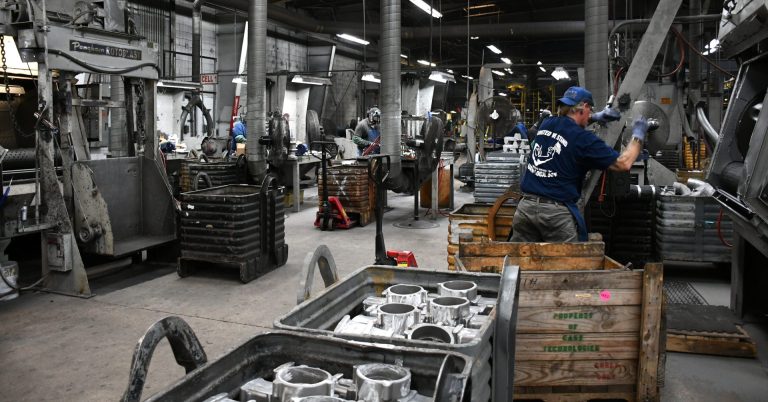Enhancing Performance: Unleash the Power of Aluminum Casting for Superior Products
Enhancing Performance: Unleash the Power of Aluminum Casting for Superior Products
Blog Article
Discovering the Numerous Techniques of Light Weight Aluminum Spreading: A Comprehensive Overview
Light weight aluminum casting stands as a basic process in the production of many products we run into daily, from elaborate automotive elements to home components. Comprehending the varied techniques utilized in light weight aluminum spreading is vital for producers looking for accuracy and performance in their production procedures - aluminum casting. As we begin on this expedition of the different strategies included in light weight aluminum casting, we discover a globe where development and practice converge to form the products that shape our modern-day world
Sand Casting Approach
Utilizing one of the earliest and most widely utilized approaches in aluminum casting, the sand spreading method includes developing molds from a combination of sand and a binder material. This method is very versatile, economical, and ideal for producing a broad array of sizes and shapes, making it a prominent selection in numerous industries.

Light weight aluminum, heated to its melting factor, is then poured right into the mold, loading the tooth cavity. After solidifying and cooling down, the sand mold is escaped, revealing the light weight aluminum casting. This method enables for the production of complicated geometries and is well-suited for both reduced and high quantity manufacturing runs.
Investment Casting Strategy
Having checked out the sand casting approach, a polished method to aluminum spreading is the investment spreading technique, which uses distinct advantages in terms of accuracy and surface coating. Investment casting, additionally called lost-wax spreading, is a procedure that includes developing a wax pattern that is coated with a ceramic shell. Once the covering is dried and solidified, it is warmed to remove the wax, leaving behind a hollow ceramic mold and mildew. Molten aluminum is then put right into the tooth cavity, loading the mold to produce the wanted component.
Additionally, investment spreading is recognized for its exceptional dimensional accuracy and tight resistances, making it a favored technique for generating components that need tight specifications. On the whole, the financial investment casting technique is a efficient and versatile approach for making high-grade light weight aluminum components.
Irreversible Mold And Mildew Process

One of the key advantages of the Irreversible Mold Refine is its ability to produce components with a finer grain structure, resulting in improved mechanical residential or commercial properties. By leveraging the Irreversible Mold Process, suppliers can achieve economical manufacturing of aluminum components with superb dimensional accuracy and surface area finish.
Pass Away Casting Approach
In comparison to the Irreversible Mold Process, the Die Casting Strategy for aluminum spreading entails utilizing a recyclable steel mold and mildew to generate intricate parts with high dimensional precision. This approach is widely Continue made use of in various markets because of its capacity to successfully mass-produce complex shapes with thin walls and exceptional surface area coatings.
Pass away casting typically begins with the preparation of the steel mold, which is after that sprayed with a lubricant to help with the removal of the solidified aluminum. The mold is closed, like it and molten aluminum is injected under high pressure into the cavity. Once the light weight aluminum cools and strengthens, the mold and mildew opens up, disclosing the completed part.
One of the essential advantages of die casting is its high production price, making it an economical solution for massive production. In addition, components generated via die spreading display remarkable stamina and sturdiness compared to those made through other casting approaches. This method is particularly suitable for applications requiring detailed layouts, limited tolerances, and high repeatability.
Centrifugal Casting Approach
Exactly how can the Centrifugal Casting Method boost the effectiveness and quality of light weight aluminum spreading processes? Centrifugal casting is an approach that uses centrifugal force to disperse molten metal right into a mold cavity. This strategy uses numerous benefits over standard casting approaches.
One secret advantage is the remarkable quality of the spreadings created. The centrifugal pressure assists to get rid of porosity by pushing any kind of gas or pollutants in the direction of the center of the spreading, leading to a denser and more consistent final item (aluminum casting). Additionally, the official website rotational activity of the mold ensures an extra even circulation of the liquified metal, bring about enhanced mechanical homes and lowered problems
The approach permits for the casting of intricate shapes and thin-walled parts with ease, broadening the style possibilities for makers. In final thought, the Centrifugal Spreading Technique stands out as a trusted method for improving both the effectiveness and high quality of light weight aluminum casting processes.

Verdict
To conclude, the numerous techniques of light weight aluminum casting provide unique advantages and characteristics for different applications. Sand spreading provides convenience and cost-effectiveness, investment spreading permits complex designs, long-term mold and mildew process guarantees top quality coatings, die casting supplies high manufacturing rates, and centrifugal spreading generates high-strength components. Comprehending the distinctions between these techniques can aid makers pick the most appropriate strategy for their specific casting requirements.
Having actually explored the sand casting technique, a polished technique to light weight aluminum spreading is the investment casting method, which uses distinctive benefits in terms of accuracy and surface finish. Investment casting, likewise understood as lost-wax spreading, is a procedure that entails producing a wax pattern that is covered with a ceramic covering.Just how can the Centrifugal Spreading Approach enhance the efficiency and quality of aluminum casting processes? In conclusion, the Centrifugal Casting Method stands out as a reputable method for improving both the effectiveness and high quality of aluminum casting processes.
Sand casting offers versatility and cost-effectiveness, investment spreading permits for detailed layouts, long-term mold procedure makes sure top quality finishes, pass away casting gives high manufacturing prices, and centrifugal spreading generates high-strength components.
Report this page